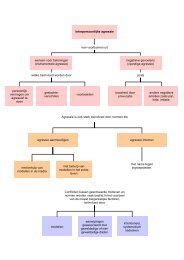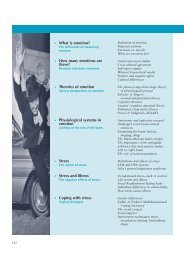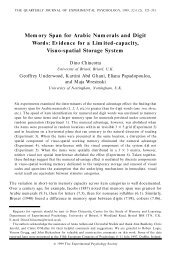Chapter 18: Cognition and Emotion - Psychology Press
Chapter 18: Cognition and Emotion - Psychology Press
Chapter 18: Cognition and Emotion - Psychology Press
Create successful ePaper yourself
Turn your PDF publications into a flip-book with our unique Google optimized e-Paper software.
12 COGNITIVE PSYCHOLOGY: A STUDENT’S HANDBOOK<br />
Design for a study of mood-statedependent<br />
memory together with<br />
the predicted results on Bower’s<br />
(1981) theory.<br />
Mood-state-dependent memory<br />
FIGURE <strong>18</strong>.7<br />
Mood state at learning<br />
Happy<br />
Happy<br />
Sad<br />
Sad<br />
Mood-state-dependent memory has typically been<br />
studied by having the participants initially learn<br />
one or two lists of words. Learning occurs in<br />
one mood state (e.g., happy or sad), <strong>and</strong> recall<br />
occurs in the same mood state or in a different<br />
one (see Figure <strong>18</strong>.7). When two lists are presented<br />
(e.g., Bower, Monteiro, & Gilligan, 1978;<br />
Schare, Lisman, & Spear, 1984), one list is learned<br />
in one mood <strong>and</strong> the other list is learned in a<br />
different mood. After that, participants are put<br />
back into one of these two moods <strong>and</strong> they are<br />
instructed to recall only the list learned first.<br />
Recall should be higher when the mood state at<br />
the time of recall is the same as that at the time<br />
of learning.<br />
Schare et al. (1984) <strong>and</strong> Bower et al. (1978)<br />
obtained mood-state-dependent recall with the<br />
two-list design but not with the one-list design. It<br />
is possible that participants trying to recall the<br />
first list with the mood appropriate to the second<br />
list thought of some of the words from the second<br />
list, <strong>and</strong> this interfered with the task of recalling<br />
first-list words.<br />
Ucros (1989) reviewed 40 published studies<br />
of mood-state-dependent memory. There was a<br />
moderate tendency for people to remember material<br />
better when there was a match between the<br />
mood at learning <strong>and</strong> that at retrieval. However,<br />
the effects were generally stronger when participants<br />
were in a positive mood than a negative<br />
mood. This may well be because individuals in a<br />
negative mood are motivated to change their mood<br />
state (discussed in more detail later).<br />
Ucros (1989) also found that mood-statedependent<br />
effects were stronger when the learning<br />
Mood state at recall<br />
Happy<br />
Sad<br />
Happy<br />
Sad<br />
Predicted level of recall<br />
High<br />
Low<br />
Low<br />
High<br />
material had personal relevance. According to<br />
Bower’s (1992) causal belongingness hypothesis,<br />
memory is mainly affected by mood state when<br />
participants believe that their emotional state at<br />
learning is caused by the to-be-learned material.<br />
Causal attribution leads to an effective association<br />
between the material <strong>and</strong> the emotional state.<br />
This is much more likely to occur with personal<br />
events (e.g., feeling delighted after succeeding<br />
in an important examination) than when an<br />
emotional state is induced before presenting the<br />
learning task.<br />
Kenealy (1997) noted various problems with<br />
previous research. First, the level of learning was<br />
not assessed in most studies. As a result, it is not<br />
clear whether poor performance reflected deficient<br />
memory or deficient learning. Second, there was<br />
no check in some studies that the mood manipulations<br />
had been successful. Third, only one memory<br />
test was generally used. However, the extent of<br />
any mood-state-dependent effects on memory<br />
often depends on the nature of the memory test.<br />
For example, Kihlstrom (1991) suggested that<br />
the effects of mood state will be weaker when<br />
rich <strong>and</strong> informative cues are provided within the<br />
retrieval environment (e.g., cues on a test of cued<br />
recall).<br />
Kenealy (1997) addressed all these issues in a<br />
series of experiments. In one study, the participants<br />
looked at a map <strong>and</strong> learned a set of instructions<br />
concerning a particular route until their learning<br />
performance exceeded 80%. The following<br />
day they were given tests of free recall <strong>and</strong> cued<br />
recall (the visual outline of the map). There<br />
were strong mood-state-dependent effects in free<br />
recall but not in cued recall (see Figure <strong>18</strong>.8).<br />
Thus, mood state can affect memory even when





